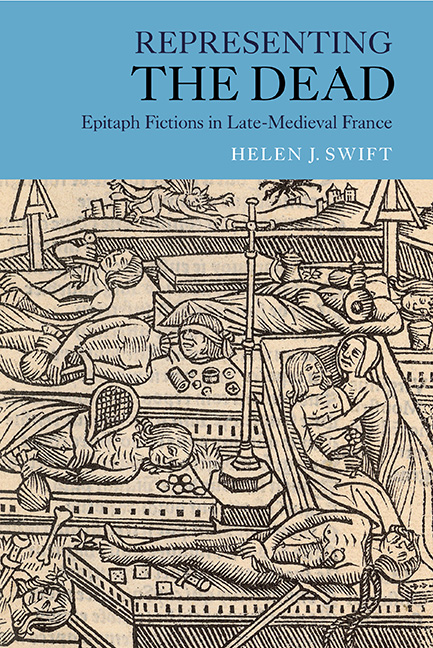Book contents
- Frontmatter
- Dedication
- Contents
- List of Illustrations
- Acknowledgements
- Note on Quotations
- List of Abbreviations
- Chronology of Epitaph Fictions
- Introduction: Representing the Dead
- 1 Framing Identity: ‘je suis’ and ‘cy gist’
- 2 Identity and/as Echo: the ‘Belle Dame’ querelle and Le Jardin de plaisance
- 3 Dying to be told: storytelling and exemplarity ‘selon le stile Jehan Bocace’
- 4 Placing the Dead: Cemeteries, Hospitals and Temples
- Afterword: Illustrating the dead
- Coda: Re-Member Me
- Appendix: Early Editions of the Jardin de plaisance et fleur de rethorique
- Bibliography
- Index
- Already Published
3 - Dying to be told: storytelling and exemplarity ‘selon le stile Jehan Bocace’
Published online by Cambridge University Press: 17 June 2021
- Frontmatter
- Dedication
- Contents
- List of Illustrations
- Acknowledgements
- Note on Quotations
- List of Abbreviations
- Chronology of Epitaph Fictions
- Introduction: Representing the Dead
- 1 Framing Identity: ‘je suis’ and ‘cy gist’
- 2 Identity and/as Echo: the ‘Belle Dame’ querelle and Le Jardin de plaisance
- 3 Dying to be told: storytelling and exemplarity ‘selon le stile Jehan Bocace’
- 4 Placing the Dead: Cemeteries, Hospitals and Temples
- Afterword: Illustrating the dead
- Coda: Re-Member Me
- Appendix: Early Editions of the Jardin de plaisance et fleur de rethorique
- Bibliography
- Index
- Already Published
Summary
ex alienis casibus quam in lubrico positi sitis advertite. (DCVI, IX.xxvii, p. 868)
[From the fates of others realize how perilous your state is.] (Fates, p. 242)
In the BDSM querelle, we saw characters posthumously being spoken about in an attempt to redeem their renown and establish their identity for its own sake (or for the sake of their heirs). A contemporary cluster of similarly intertextually linked epitaph fictions features subjects presenting themselves in order to underscore their poor reputation, accept their unfortunate fate and put themselves forward as negative exempla; their identity and the value of their life story derive from their fall, ultimately towards death. This kind of self-promotion, whilst still competitive (with figures jostling for representative pre-eminence: the most wretched, the most degenerate …), is thus intended to serve others: their exemplary tales are marshalled didactically as a cautionary warning against Fortune, an exhortation to ‘rappeller au droit chemin ceulx qui sont desvoiez’ [to recall to the right path those who have strayed]). In TB, for instance, according to its narrating persona Georges, Othon de Grandson ‘desiroit fort, ce sembloit, pour estre exemple a ceux qui se presument en vanité de leurs corpz, ester recheu droit cy et mis en ascout, car s’y presentoit a ceste cause’ (TB, p. 37 [was very keen, it seemed, in order to serve as example to those who are presumptuous through physical vanity, to be received here and heard, since he presented himself here for that reason]). Such figures are, therefore, dying to be told: becoming story by dint of being posthumous (recalling Lyotard), but also seeking energetically to ensure record of their fate by a third party, the persona of the text in question.
The cluster consists of texts published between 1400 and 1513 in translation of, or response to, Giovanni Boccaccio's De casibus virorum illustrium: Laurent de Premierfait's two translations, Des cas des nobles hommes et femmes (1400 and 1409); George Chastelain's Temple de Bocace (1463–65); Antitus's Portail du Temple de Bocace (1501); and Laurent Desmoulins's Cymetiere des malheureux (1511; re-edited 1513). This is by no means a complete list of fifteenth-century and early-sixteenth-century literary texts that stand in some measure as remaniements of DCVI; as the Italian author's most numerously produced work in late-medieval France, its impact was well disseminated.
- Type
- Chapter
- Information
- Representing the DeadEpitaph Fictions in Late-Medieval France, pp. 146 - 200Publisher: Boydell & BrewerPrint publication year: 2016

